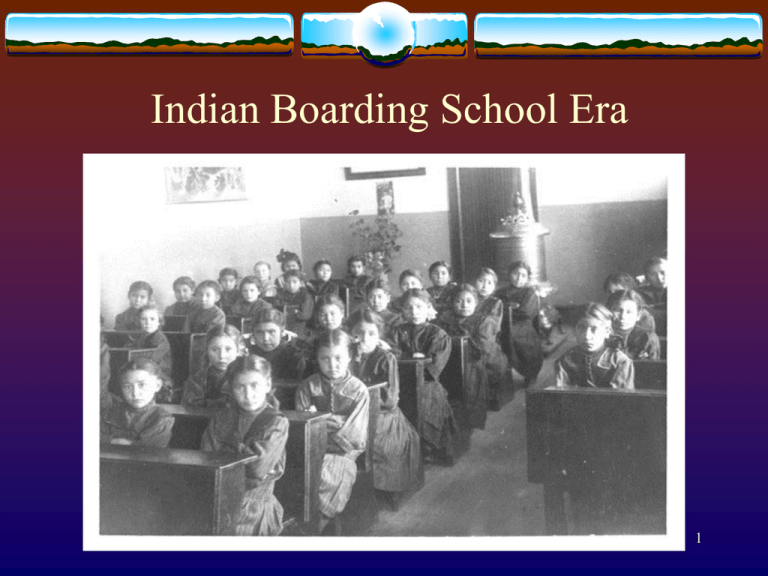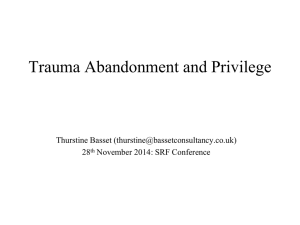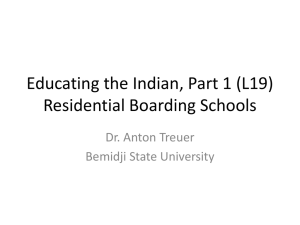6th Boarding Schools - Butte School District # 1
advertisement

Indian Boarding School Era 1 Indian Boarding School Era To the White Society, Native People: were heathens and behaved like savages. had no written language. were unschooled. didn’t know how to stay in one place. had to be “civilized” or assimilated through education. 2 Indian Boarding School Era The boarding school era began in the 1800s and continued through the 1950’s. The federal government forcibly placed tribal children in the harsh, military like institutions to: assimilate or civilize the children. 3 Indian Boarding School Era 1850’s Treaties with Indians included educational support for the tribes. 1870’s Boarding schools opened on reservations. 1879 First (off-reservation boarding school) opened at Carlisle, PA. 1890’s Other boarding schools were built across the West. 4 Indian Boarding School Era 1900’s Boarding school system grows over the next two decades. 1928 Meriam Report commissioned by the Interior Department supplied information on boarding schools : condemns schools’ deficient diets. overcrowded dorms. poor medical service. overworking of students. 5 Indian Boarding School Era 1930’s Meriam Report brought about reforms in boarding schools. Teacher training Better living conditions Better treatment of children Boarding schools became open to tribal culture 1934 Some boarding schools closed throughout the U.S. 1950’s Some boarding schools still existed. * This is considered a dark and unfinished chapter in American History. 6 Indian Boarding Schools In the beginning, schools were established on the reservations. Students could go home at the end of the school day. Parents could visit their children at school. They were exposed to both cultures – native and whiteman. Assimilation process was taking too long. 7 Indian Boarding Schools Changes took place: Boarding schools were opened far away from reservations. Students had no contact with their families and friends. Parents were discouraged from visiting. Students were only allowed to go home at certain times of the year – Christmas and summer. Parents who openly resisted giving up their children lost food rations or were jailed. 8 Indian Students at School Students at schools were given rules and had no choices: started boarding school at age 5. left boarding school at age 18. could not use their own name. were given a whiteman’s name. students’ hair was cut short. had to wear uniforms. 9 Indian Students at School RULES: were forbidden to speak their language. students lost the ability to speak their native language fluently because of the years in school. were forbidden to practice their religion. were forced to memorize the Bible and the Lord’s Prayer. 10 Indian Students at School RULES: boys and girls lived in separate dormitories. boys and girls had no privacy. their days were filled with many tasks. every task began and ended by bells or “triangles”as they were called. 11 Indian Students at School were taught that they were being civilized or “raised up” to a better way of life. were told that Indian people who retained their culture were stupid, dirty, and backwards. “Good Indians” were those who assimilated quickly. “Bad Indians” were those who did not assimilate quickly. 12 Indian Students at School PUNISHMENTS disobeying the rules meant swift and harsh punishment. forms of punishment used: strapping – being hit many times with a leather strap being locked in a closet. being made an example of in front of the other children. For first-person experience, see this site. 13 Boarding School System “half and half” students spent: “half of the day in the classroom” and “ half of the day on work assignments” or “detail” on the school grounds. the work performed by students was essential to the operation of the institution. 14 Boarding School System Academic Curriculum - U. S History - Geography - Language - Arithmetic - Reading - Spelling & Writing Work Details - Cooking & Sewing - Laundry & Cleaning - Carpentry & Shop - Blacksmithing - Baking - Farming 15 Boarding School Jobs Boys - carpenters - gardeners - wood choppers - blacksmiths - wagon makers - shoemakers - animal caretakers Girls - sewing - pastry cooks - laundry workers - cooking - cleaning - nursing - office workers 16 Boarding School Day 5:45 – 5:55 a.m. Reveille - everyone is awakened. - kneel on floor and say prayers. 5:55 – 6:12 a.m. Washing, brushing teeth & getting dressed. 6:12 – 6:45 a.m. Go to morning mass - kneeling in pews (no sitting) 6:45 a.m Roll call for breakfast 17 Boarding School Day 7:00 – 7:30 a.m. Breakfast – gooey mush with powder milk and brown sugar. 7:30 – 7:40 a.m. Care of teeth and make beds. 7:40 – 7:55 a.m. Inspection of beds and area. 7:55 – 8:50 a.m. Reading books, music lessons & athletics. 8:50 – 9:00 a.m. Roll call for school. 18 Boarding School Day 9:00 – 11:30 a.m. 11:30 – 11:55 a.m. 11:55 a.m. 12:00 – 12:30 p.m. 12:30 – 12:50 p.m. 12:50 p.m. School Free time – students at liberty. Assembly and Roll Call. Lunch – soup and milk. Recreation Roll call for student’s jobs. 19 Boarding School Day 1:00 - 4:30 p.m. Work duty – students’ jobs. 4:30 – 5:25 p.m. Drill and Gymnasium classes. 5:25 p.m Roll Call for dinner. 5:30 – 6:00 p.m. Dinner – cabbage stew, bread with butter and wrinkled apples for dessert. 20 Boarding School Day 6:00 – 6:10 p.m. Care of teeth 6:10 – 7:15 p.m. Recreation – outside playing of choice 7:15 – 7:25 p.m. Roll Call and Inspection 7:25 – 8:15 p.m. Lecture – people in education talk to students. 21 Boarding School Day 8:15 – 8:45 p.m. Call to quarters * get ready for the next day. 8:45 p.m. Students retire to bed. 8:55 – 9:00 p.m. Bed check. 9:00 p.m. Taps played * students expected to go to sleep. 22 Today’s School Day 7:00 – 7:45 a.m Students are awakened by parents or an alarm clock. Get dressed, eat breakfast, get ready to leave for school. 7:45 – 8:10 a.m Students ride the school bus or are driven to school by parents. 8:10 – 8:25 a.m. Students play outside or have breakfast at school. 8:25 a.m. Bell rings, students line up according grade level. 23 Today’s School Day 8:30 a.m. Students are greeted by their teacher and enter the school building. 8:30 – 8:45 a.m. Attendance is taken, lunch count and pledge is recited. 8:45 – 10:30 a.m. Reading 10:30 – 11:30 a.m Art/ Music/Physical Education (depending on the day of the week). 11:30 – 11:55 p.m. English 11:55 – 12:00 p.m. Get ready to go to lunch. 24 Today’s School Day 12:00 – 12:20 p.m. Lunch - students may buy lunch at school or eat whatever was sent from home. 12:20 – 12:30 p.m. Recess – outdoor play. 12:30 p.m Students line up; are greeted by teacher; enter the building. 12:35 – 1:30 p.m. Math 1:30 - 2:10p.m. Science 2:10 - 2:50 p.m. Social Studies 25 Today’s School Day 2:50 - 3:00 p.m. Get ready to leave for the day and go home. Students walk out with teachers to their parents or bus. 3:00 - 9:00 p.m. Students are free to be involved in sports, dance or other activities. Students eat dinner with family members at different times of the evening and have many choices of food. Bedtime is decided by parents and varies in times. Once in bed, students might listen to music or read a book. 26 Indian Boarding Schools Negatives - runaways - harsh punishments - crowded conditions - illnesses - basic medical care - deaths of students Positives - friendships - playing of games - running water - showers - clean clothes - decent food 27 Pro/Con Debate Activity Divide class into three groups PRO CON TIMER PRO & CON sit back to back in pairs with a timer for each pair. Timer gives 30 seconds for PRO to give their side of how Boarding Schools were positive for Native American Children. Timer gives 30 seconds for CON to give their side of how Boarding Schools were negative for Native American Children. Repeat activity until all three roles – PRO, CON & TIMER – have been done by each group member. 28 Boarding School Photo Gallery Boarding School photos: http://www.english.uiuc.edu/maps/poets/a_f/erdrich/ boarding/gallery.htm 29 Review Questions 1. How were the students expected to dress and wear their hair? 2. How long did they stay at the boarding school and how often did they go home? 3. What name did they use at boarding school? 4. What were they expected to learn besides work skills? 5. What kind of jobs were assigned to boys? 30 Review Questions 6. 7. What kind of jobs were assigned to girls? What kind of punishment was given for disobeying rules? 8. What was a “good Indian”? 9. What was a “bad Indian”? 10. List some “positives and negatives” of boarding schools. 31 Assimilation Lesson ( for teacher) Title: The Price of Assimilation – What It Costs a Society When Everyone is the Same. Lesson: Students will identify ways that a society promotes assimilation and examine areas where it still occurs in our present culture. Students will also assess the value of assimilation. • Why do we feel people should be the same or do the same things? • What do we lose as a society if everyone conforms to the same image or idea? • Why did the early “Americans” fee assimilation was best? • What did this policy cost our nation? • How did attempts at assimilation affect the people involved? (psychological, social, governmental, physical effects) 32 Assimilation Lesson (for teacher) 1. 2. This lesson is best limited to one day or class period with younger students. It has been done with students as young as first grade, but is somewhat controversial because sometimes very young children do not have the reasoning skills necessary to understand the purpose of the lesson. Fourth grade and above should understand without issue. Divide the class into groups by eye color. Give each group a colored armband or other group signifier. Construct a strict set of social rules: (i.e. The blue group always goes to lunch first. The brown group cleans up after every project. The blue group gets all the pens and pencils they need. The green group can only use one crayon. Etc. 33 Assimilation Lesson (for teacher) 3. 4. Change it all around. Invite the principal, who has blue eyes, to reestablish a new social order. Continue making changes until all the children have had a chance to participate as the group at the tope of the social ladder and the group at the bottom. To make the game a further challenge, add rules that can lead to demotion. For instance, if a person of high rank is seen hanging out with a person/people of low rank too often, he/she will be demoted one class because he/she obviously has no concern for reputation in associating with people of poor character. 34 Assessment of Lesson(for students) 1. After finishing the game ask students to journal their answer to questions like these: How did you feel as a person of highest rank? How did you feel as a person of lower rank? Were there times when you felt like you couldn’t control your own life? Were there times when you felt like you were treated unfairly? What makes treatment unfair? Did you feel like you changed the way you acted when your social position changed? Did you ever feel limited in what you could achieve? Who made the rules of your society? Were they just or unjust rules? 35 Assessment of Lesson(for students) What purpose did the rules serve? Does a society need rules to function? If yes, what kinds of rules are necessary. If no, how does a society function without rules? In American society, what rules do we live by? Who made these rules? Are these rules just or unjust? What do our rules reflect about our society? 36 Compare and Contrast Activity Read the following books together, as a class: Walking in Beauty by Susan Kent (partner read) Shi-shi-etko by Nicola I. Campbell (teacher reads to class) Do the Compare and Contrast Activity that follows: List 5 facts on each part of the diagram. 37 Compare and Contrast: Shi-shi-etko and Walking in Beauty Walking in Beauty Shi-shi-etko 1______________ 2______________ 3______________ 4______________ 5______________ Both books 1_____________ 2_____________ 3_____________ 4_____________ 5_____________ 1_____________ 2_____________ 3_____________ 4_____________ 5_____________ 38 Shi-shi-etko • Click on the image of the activity shown at right. • The activity will load as a Microsoft Word page (stored on the web). Please give it time to load fully. • When the activity is fully loaded, you will be able to see a 4-way arrow on the borders of the colored boxes as click on each box and scroll over its borders. When the 4-way arrow is visible, have a student drag and drop each colored box to its correct column. • After finishing the activity, click on the close box (the “x” in the righthand corner) to return to this slide and DO NOT SAVE when prompted. Walking in Beauty Shi-shi-etko and Walking in Beauty Talks about worries about going to school Always Running Loves to Play in Water Talks about her problems at school She needs to remember the ways of the poeple She runs away back to her homeland Geography was her best subject Her new name is Alice Shi-shi-etko Yayah gives her a sinew bage She sets off to go to school Walking in Beauty 39









